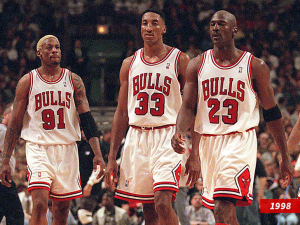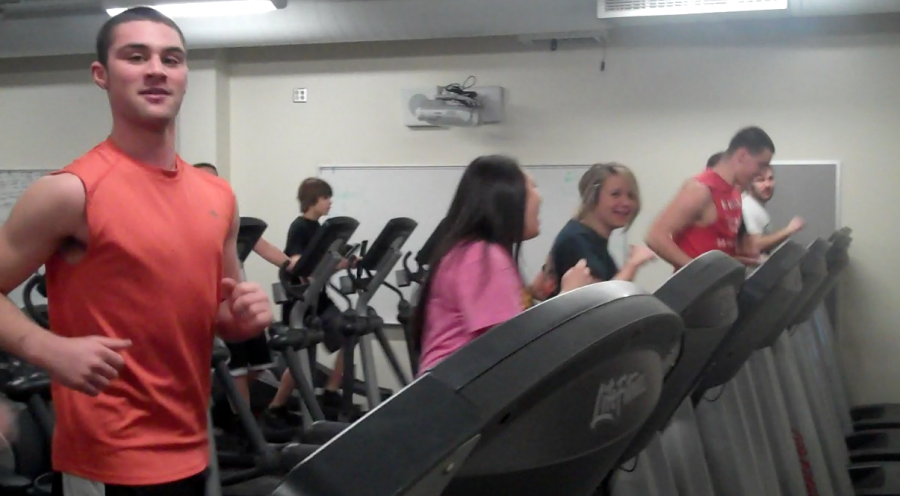At Bethel Park High School, the Physical Education curriculum has always been centered on arduous fitness courses that aim to chisel students into fit, confident young adults. The Physical Education teachers are the cornerstones of the athletic wing, as they implement unique and fresh fitness components for students to lead a healthy life. In addition, the Phys. Ed. department accommodates students and lends students a helping hand when they are in a time of need.
Phys. Ed. teachers Mrs. Thomas, Ms. Serafin, and Mrs. Malley say, “Our focus has always been in providing students with the tools and knowledge that they will need in order to live a long and healthy life.”
Nonetheless, students have always had to enroll in P.E. for four years, at .25 of a credit each year to meet the state minimum of 1 credit; however, the School Board has recently modified this. Next year, the incoming freshman are only required to take gym their freshman and sophomore year, which means the credit has now been boosted up to .5 of a credit instead of .25.
There is a clear division between the Physical Education Department and the School Board on this decision.
Obesity is one cause for the divide as it is prevalent and widespread throughout the United States in this day and age. In fact, Centers for Disease Control and Prevention’s (CDC) website states that 28.6% of Americans are obese in the state of Pennsylvania.
At Bethel Park High School, over 25% of the students are obese.
Football coach, Mr. Metheny points out, “I have the percentages for Body Max Index from 2005 all the way through now. Basically, we [students of BPHS] are anywhere between 27 and 30%, which is just shy of the national norm. This is morbidly obese. This is ridiculous in today’s society with how intelligent kids are that we would let our youth be this morbidly obese when we know it’s bad for them; these students will develop self-esteem issues, interacting with other people issues, and health issues. Right now, statistics say that the children growing up today are going to be the first generation in a long long time that are going to live fewer years than their parents.”
What will these numbers looks like in a few years after only two years of Physical Education?
Especially in a society that now pushes for health and wellness, a decision to cut back on Physical Education seems counter-cultural.
According to the School Board’s decision, students will have the opportunity to take gym as an elective their junior or senior year if they wish. For some students P.E. is the only physical activity that students get. Students that are in athletics may take gym as an elective, but what is the probability that the students that are inactive will take gym as an elective? This pins the physical education department in a perplexing situation.
Currently, the Physical Education department is establishing a concrete plan and curriculum that will save jobs and Physical Education for students across the District.
The modification of the Phys. Ed. curriculum could be changed by as early as next year. Since the Board is already valuing the credit of gym as .5, the department is forced to scheme and brew up a plan to lure and entice students to take gym as an elective their junior and senior year.
Soccer and hockey coach, Mr. Santora states, “[The decision by the Board] is very counterproductive and I don’t think it’s going to have any positive impact on our students. . .”
If the School Board’s plan is upheld, what will the Phys. Ed. department do to ensure that students are benefiting as much as possible from Physical Education?
According to Mr. Santora, “Nothing is official yet. We still have a lot of work to do as a department and to decide what direction we want to take our program in. Do we want to have it more activity-based, as in the three day activity and two day fitness, opposite of what we have know. Or, do we want to take it to five days of activity. Or, do we want to have completely different classes for juniors and seniors versus freshmen and sophomores (if the Board changes the credit to .5); the problem with that is that it separates everybody, and in ninth and tenth grade you might think that Phys. Ed. is awful and you may only partially enjoy it. Well, then you might be more reluctant to take it as an upperclassman, because it was more challenging.”
Mr. Santora highlights that if the Phys. Ed. department gears the curriculum towards an activity-based program for the upperclassmen, then maybe that will entice more students to take it as an elective.
However, Mrs. Thomas, Ms. Serafin, and Mrs. Malley all say, “The 9th and 10th grade PE expectation will remain the same. 3 days fitness and 2 days activity. We are still discussing a different type of program for the 11th and 12th graders.”
The list of benefits of Physical Education goes on and on. Studies worldwide show that P.E. increases test scores, GPA, and personal achievements. Even Mr. Metheny notes that standardized test scores will improve if the student is involved in PE. There is no hiding the fact that exercise gets the blood flowing, which in turn improves concentration.
In today’s culture, school districts around the country are making adjustments, refining, and tweaking the physical education curriculum to better the health and welfare of students. Most of these adjustments are technological advancements and enhancements that improve the efficiency of athletic equipment. At one point, Bethel Park was no different from all of these other school districts.
On another note, with the construction of the new high school, Bethel Park has provided students and teachers with ultramodern athletic equipment, devices, and facilities. Fortunately, the District has provided these faculties that are the forefront of the educational system within Pennsylvania and even the United States.
About this, Coach Metheny asks,”If the School District just spent $25 million on athletic facilities, then why would they eliminate, in three years, 800 of the students from participating in gym?”
In regards to the new athletic facility, Coach Metheny adds, “Dana Holgorsen, football coach of West Virginia University, came to Bethel Park High School and said we had better facilities than they do, in terms of outdoor facilities.”
Thus, the Physical Education department wants these state-of-the-art athletic facilities to be used to the utmost and in the way that they were intended. A reduction in Phys. Ed. will evidently yield the opposite effect for there won’t be as many students there to use the facilities and if there are less students, then there will be less options, thus leaving some of these facilities to collect dust.
Clearly, the decision to reduce Physical Education doesn’t sit well with the Physical Education department. Mr. Santora notes that the only thing that can change the School Board and administrations’ minds are the voices of the student body.
Regardless of what becomes of this, the students’ physical, mental, and emotional well-being will be held in the balance.














anonymous • May 24, 2013 at 1:31 pm
A new article says PE should be a core program and at least 45 minutes provide daily to high school students. This seems to indicate that the school board should reverse it’s decision and reinstall phys ed as a core program. It looks like the state may be getting more funds for schools next year, and if funding is a problem, the board should hire a czar to start collecting private funds. This would be a creative way to get the funds to support this program. It doesn’t seem right to let all these great new phys ed facilities go to waste. I know some parents want their kids to load up on reading and writing to get ahead for college, but it should not be done at the expense of their kid’s health.
HOUSTON, May 23 (UPI) — U.S. experts recommend U.S. schools be responsible for helping pupils engage in at least 60 minutes of vigorous or moderate intensity activity each school day.
Harold W. Kohl III, professor of epidemiology and kinesiology at The University of Texas School of Public Health, part of The University of Texas Health Science Center at Houston, said currently more than half of U.S. youth meet current evidence-based guidelines of at least an hour of vigorous or moderate intensity physical activity daily.
“Because children are in school for nearly half of their waking hours, the committee recommends a Whole-of-School approach to strengthening physical activity in schools,” Kohl said in a statement.
“The approach would target physical education, active commuting, before and after-school activities, sports and other opportunities to help children meet the 60 minutes per day of vigorous or moderate intensity physical activity.”
Kohl, who chaired the committee that wrote the report for the Institute of Medicine, said the Whole-of-School approach would encourage activities such as walking or riding a bike to school while discouraging inactivity.
Recess, lunch breaks and frequent classroom breaks should be included and not taken away as punishment, the report said.
Although many state laws require some physical education, the report urged the U.S. Department of Education to include physical education as a core subject.
“Physical activity is so central to children’s health, development and learning schools should naturally be involved with physical activity for students,” Kohl said. “Research shows physical activity helps children think faster, improves their cognitive performance and helps them reach their academic
Read more: http://www.upi.com/Health_News/2013/05/23/Schools-should-provide-more-than-gym-for-physical-activity/UPI-62831369328772/#ixzz2UEQz60sm
Student • Apr 5, 2013 at 3:03 pm
I don’t understand why you keep trying to shut this down. It is absolutely unnecessary to cut gym when THE UNITED STATES is the most obese country in the entire world.
Brenda Payseure • Mar 27, 2013 at 9:01 am
Eliminating the requirement of juniors and seniors to take PE will not leave the facilities gathering dust. Such exaggerations are silly. I do not think anyone in the community is naive enough to think the athletic facilities throughout the district, not just at the high school, are there solely for student PE classes. They are widely used after school hours too. For instance there was considerable conflict over lack of availability of the weight room after school. I am not trying to shut anything down, I do not know what you mean by that comment.
The CDC has no data specific to Bethel Park. If the PE program is phenomenal then by 11th grade it will have instilled the love of physical activity in students and they will want to chose it as an elective. It is puzzling that you think it will not. Yes, as a taxpayer I help pay the bill for all of these fabulous facilities that members of the community asked for but all the rec and extra curricular sports in BP means we have unfit children?? That just doesn’t make sense to me and has nothing to do with forcing students to take 2 more semesters of 40 minute PE classes.
anonymous_2 • Apr 10, 2013 at 6:59 pm
Brenda
Your point is that by the 11th grade students should be mature enough to take physical ed as an elective. What the CDC is saying that most don’t take it as an elective, so they should be forced to take it in high school. That is their recommendation, obviously you dont agree.
Your point is valid, apparently we are failing our children, perhaps it isnt the schools fault. It may be more related to the overall culture.
that is so high pressure to be the best even at the expense of health.
Student(s) • Mar 15, 2013 at 10:19 pm
Brenda,
You make some extremely valid remarks. However, I would have to disagree with you in many aspects. Actually, if you research it, Upper St. Clair and Peters require 4 years of PE, but their obesity statistics are sky-high. Why is that? Because, students don’t feel the need to go home and eat a balanced diet. They feel like gym is enough, which it is not. The gym program is phenomenal, which is why I don’t understand why you are trying to shut this down. It doesn’t make any sense to me. Why did you AS A TAXPAYER just pay for a multi-million dollar facility? To have great athletic programs and equipment. Don’t you want to use them? Or do you want them to gather dust, so it can make taxpayers irate?
anonymous_2 • Mar 15, 2013 at 1:09 pm
Hello Brenda
You are entitled to your opinion, however the CDC doesnt agree. The CDC has extensive data that students arent flocking to gym,and has made recommendations that high schoolers, get no less than 60 minutes of exercise per day. What is the the next step, elimination of the elective. Once we start going down this road there is no end. This is simply a move to save costs, and it is truly unfortunate.
This was an excellent article, and very timely in nature.
Brenda Payseure • Mar 12, 2013 at 9:17 am
Anony, as Student replies he/she thinks the program works well. One of the best attributes of the BP PE program is the exposure of students to varied fitness routines that they may wish to pursue on their own. The goal of the district is to produce life-long learners and the goal of PE should be to produce an interest in lifelong fitness. Go with the strength of the program. If no one choses PE as an elective in their junior and senior years then that speaks to the value of what they received beforehand. I don’t think that will be the case. I think it is sad to see a ‘push’ for a program that apparently so few including the PE teachers seem to have faith in. If the program is there and is suitable for all students, they will come. Look at area gyms, look at college gyms, they are packed. The idea is to instill the desire and understanding of the need for fitness. If that is done, students will flock to the program. Four years is not required in other surrounding districts, are their students less fit, more obese? Do none of them take PE as an elective? This is much ado about nothing IMO.
anonymous • Mar 15, 2013 at 11:39 am
Hello Brenda
This is important, imho. The CDC has issued guidelines indicating the importance of physical education, see below. i think one needs to consider their recommendations.
Implement a comprehensive physical activity program with quality physical
education as the cornerstone.
Children and adolescents should participate in 60 minutes or more of physical activity every day.
A substantial percentage of students’ physical activity can be provided through a comprehensive,
school-based physical activity program that includes these components: physical education, recess,
classroom-based physical activity, walking and bicycling to school, and out-of-school-time activities.
Strategies
• Require students in grades K–12 to participate in daily physical education that uses a planned
and sequential curriculum and instructional practices that are consistent with national or state
standards for physical education.
• Provide a substantial percentage of each student’s recommended daily amount of physical
activity in physical education class.
• Use instructional strategies in physical education that enhance students’ behavioral skills,
confidence in their abilities, and desire to adopt and maintain a physically active lifestyle.
• Provide ample opportunities for all students to engage in physical activity outside of physical
education class.
• Ensure that physical education and other physical activity programs meet the needs and interests
of all students.
Resources
CDC’s Physical Education Curriculum Analysis Tool
http://www.cdc.gov/healthyyouth/PECAT
CDC’s Youth Physical Activity Guidelines Toolkit
National Association for Sport and Physical Education
anonymous • Mar 1, 2013 at 4:47 pm
Brenda,
You make an excellent point. However my fear is that most students will use any reason for not taking gym, that is why there is a big push from the CDC and many other organizations to put gym back into high schools. High schoolers aren’t getting enough exercise. It appears Bethel Park is moving counter to the national trend. Maybe exemptions to gym can be granted for good reasons.
Brenda Payseure • Mar 1, 2013 at 12:45 pm
If 27-30% of Bethel Park High school students are morbidly obese as stated by Mr. Methany, it doesn’t appear that the current PE program is working well at all. After 10 years of school PE, if the love of fitness has been properly instilled then students will choose to elect PE courses. Students are not eliminated from taking PE in their junior and senior years. They will still have that option. For years, the PE credits which were artificially lowered to be worth one half of other semester courses have hampered students who wish to take multiple science courses and have two labs or would like to take other electives in the arts.
Student • Mar 2, 2013 at 5:36 pm
Brenda,
I whole heartedly believe that PE works extremely well and does provide an ample amount of physical activity for a student to stay fit. But, the student, after gym, will go home and eat junk food. There’s a clear connection between the balance of nutrition and exercise in order to remain fit.
Matt Serafini • Mar 1, 2013 at 11:08 am
This might be the best article I’ve read on Hawkeye. Well done.